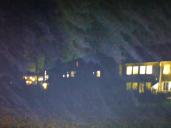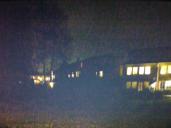
It allows to keep PV going, with more focus towards AI, but keeping be one of the few truly independent places.
-
There is a link below in this topic to download an avi file to see the problem, first let me explain it:
I did a firmware hack only changing the iso limit and set the avchd datarate to 40 Mbps.
What happens is a strange pulsing diagonal pattern in flat color areas in the image.
When I play the original mts file with windows media player there is no problem, but...
When i transcode the original mts file to avi with neoscene the problem is there in the avi file. When i render the original mts file to a h264 file the problem is there in the h264 file.
Would it be a problem in the hack footage or an issue when decoding avchd?
Link to download the mp4 video file (10MB) to see the problem:
http://www.apefos.com/upload/pulsing.mp4
Any help or knowledge share will be much apreciated. Thanks
-
I had a look - I've also seen this strange pattern on my GH2, but not recently. I've seen a lot worse on some of my footage, but it's not predictable when it will appear. But your version of it is like mine - like a diagonal waterfall but very very subtle.
I think you are right - nothing to do with neoscene or anything else, it's in the actual footage as far as I can tell. In my case I haven't seen it for a while and I have gone through a few different hacks, so I can only suggest it might be associated with what you've done in pTools? My strongest practical suggestion is simply to try a different hack and film under the same conditions as before and see if you get this issue? But keep everything the same (shutter speed, ISO etc) so you will definitely know if it's the hack (if it disappears) or something else (if it doesn't).
Maybe one of our hackmeisters can look at the file and say if it's typical of some sort of encoder stuff happening within the camera. You might want to shoot a completely locked-off, static shot with no lighting changes, and look at that footage - also look at it in Streameye or similar. I'm not an expert at the encoder stuff but again, if you have a short original .MTS clip you can share, someone here will be able to help.
-
Just remembered. I saw it really strongly where I also saw some posterisation (or banding, as some call it). It was in a shot that included an unevenly-lit white wall, and it was a sort of "cascading posterisation" effect. When I paused the footage it looked exactly like posterisation, but when playing, it was moving in one direction (can't remember if dark to light or the opposite).
So...could be associated with image noise or some other dithering effect, making posterisation move along the image somehow. Just a guess. If that's the case it wouldn't always be diagonal, it would just move at right-angles to the gradient bands.
-
Hi Mark, thank you for the inputs.
I dont think it is some kind of posterization. For me it looks like a codec breaking.
When I playback the original mts file with windows media player the footage is perfect, no issues, so maybe the wmp can handle the decoding better.
But after transcoding to avi or render to h264 the problem happens... so it seems the softwares are not decoding the original mts properly.
I will put my two cents in a bug in hack. It would be good VK take a look at this...
-
Interesting - also of course you may be seeing different things from me. I could barely see it in WMP and only because I have seen this before, so know what to look for.
An interesting one to track down. I have been using Cake 2.3 and haven't seen it at all in any of that footage - that could mean it's hack-related, or just that I haven't seen it yet. But yes, I have definitely seen it in the past - as well as using a different patch now, I have a new pc and new software so the fact I could see it before, could mean anything. It might even be down to the previous stuff I was using to look at the files.
-
The avi file i provided here for download will show the problem in windows media player or in any player because the patterns are saved in the video after transcoding to avi.
The only file that does not show the problem in wmp but shows after render is the original mts file from camera.
-
I did some more tests. I have lots of gh2 footage downloaded from internet, hacked and unhacked... So I instaled Videolan (vlc) media player to play them... The unhacked footage play good, but hacked footage shows the diagonal patern problem and in vlc player the problem is even wost. It seems each software handles decoding the hack footage better or worst than other. Some hack footage shows more problem, some show less, so it seems different hack settings gives more or less problem... So my conclusion is to try different hack settings until i find a way to solve the problem or, if i cant solve, go back to original firmware.
-
@apefos are you saying the downloaded files all have this issue? Anyway, if you just put a new setting in your camera you will soon know if it solves the problem or not. If it solves the problem, then you're good to go.
PS just remembered - off-topic I know, but you posted that amazingly useful stuff about using Neat NR. Thank you - it's changed how I use that software, and I'm really grateful.
-
Can you post a screenshot of the problem? I don't have the Cineform codec.
-
@Mark_the_Harp I uploaded some new presets for neatvideo, now with a great fine tunning, results are even better, you can download from that same topic, same place, including all iso noise profiles to load. Good to know it was helpful.
About the diagonal pattern issue: all hacked footage around 42Mbps shows the problem when play in Videolan VCL player, some mts files shows more patterns, some show less. But when transcoding to avi in neoscene some shows the problem, some does not show. It seems some hack settings are more prone to the issue and some softwares decodes better than other.
the windows media player handles the hacked footage perfectly videolan cannot handle hacked footage neoscene are in between... sometimes it does, sometimes not...
So I will try different hack settings to find a good result for avi transcoding in neoscene, if I can do that I will be good to go.
-
The download failed, but I have a pretty good idea of what I was going to see there. It's a decoder problem. Some decoders decode correctly and some don't. My guess is that some decoders have a bug or intentionally disable de-blocking to save CPU. The problem is apparent only on long GOP footage. I use ffdshow-tryout beta 7 rev 3154 with the h.264 decoder set to ffmpeg-mt, and the decoding doesn't suffer from that issue. http://sourceforge.net/projects/ffdshow-tryout/files/Old%20files/old%20releases/generic%20builds/
Edit: I just checked the short clip, and though it is not the most pronounced example of this problem that I have seen, I believe it is consistent with the decoding problem I saw before.
-
I uploaded a small mp4 video file, only 10MB, easy to download, right click and save as.
-
I don't know anything about Neoscene. As long as ffdshow-tryout is enabled for all apps and has an h.264 codec enabled and the necessary output formats enabled and high enough merit (the default output formats and merit are usually sufficient), it will be used by any DirectShow app that lets the graph be built automatically. Just open the .mts file in a DirectShow player and make sure ffdshow-tryout is the decoder. I use MPC-HC as my player. In MPC-HC you might also have to disable MPC-HC's internal h.264 decoder. You'll know that ffdshow-tryout is invoked because it puts its icon in the system tray. Check the ffdshow-tryout video decoder properties info page during playback to confirm that it is decoding AVC1 with the ffmpeg-mt h264 decoder.
But this begs the question, why transcode to Cineform at all? I use Vegas Pro 10 and edit .mts files natively, and it works just fine. If I'm dealing with simultaneous playback of several clips or files accessed across a slow LAN, I use lower bit rate proxy files to save CPU and bandwidth. Others have recommended Edius for native .mts editing.
-
I use cineform neoscene for some reasons. it upgrade the 420 color to 422, the realtime playback in timeline is much improved even in full resolution, the neatvideo noise reduction using cineform codec is much better quality, it is 10bit so any grading does not get gradients, i can render after render and it keeps the original quality, it is a professional intermediate codec.
I instaled the ffdshow and set the h264 avc to ffmpeg-mt, but when neoscene transcode the mts file to avi there is no ffdshow icon in system tray so it seems ffdshow was not invoked.
Do you have some idea what can i do?
-
Ah - ditched VLC after my computer rebuild and that might explain why I haven't seen the phenomenon since.
-
Instaled the MPC-HC player and it play fine, no problem, without ffdshow. I agree it is a decoder problem. The hacked footage is more dificult to some decoders. I think I need to ask cineform if they can improve the neoscene decoder. And I can try different gop and datarate settings in gh2 hack.
Howdy, Stranger!
It looks like you're new here. If you want to get involved, click one of these buttons!
Categories
- Topics List23,992
- Blog5,725
- General and News1,354
- Hacks and Patches1,153
- ↳ Top Settings33
- ↳ Beginners256
- ↳ Archives402
- ↳ Hacks News and Development56
- Cameras2,367
- ↳ Panasonic995
- ↳ Canon118
- ↳ Sony156
- ↳ Nikon96
- ↳ Pentax and Samsung70
- ↳ Olympus and Fujifilm101
- ↳ Compacts and Camcorders300
- ↳ Smartphones for video97
- ↳ Pro Video Cameras191
- ↳ BlackMagic and other raw cameras116
- Skill1,960
- ↳ Business and distribution66
- ↳ Preparation, scripts and legal38
- ↳ Art149
- ↳ Import, Convert, Exporting291
- ↳ Editors191
- ↳ Effects and stunts115
- ↳ Color grading197
- ↳ Sound and Music280
- ↳ Lighting96
- ↳ Software and storage tips266
- Gear5,420
- ↳ Filters, Adapters, Matte boxes344
- ↳ Lenses1,582
- ↳ Follow focus and gears93
- ↳ Sound499
- ↳ Lighting gear314
- ↳ Camera movement230
- ↳ Gimbals and copters302
- ↳ Rigs and related stuff273
- ↳ Power solutions83
- ↳ Monitors and viewfinders340
- ↳ Tripods and fluid heads139
- ↳ Storage286
- ↳ Computers and studio gear560
- ↳ VR and 3D248
- Showcase1,859
- Marketplace2,834
- Offtopic1,320






